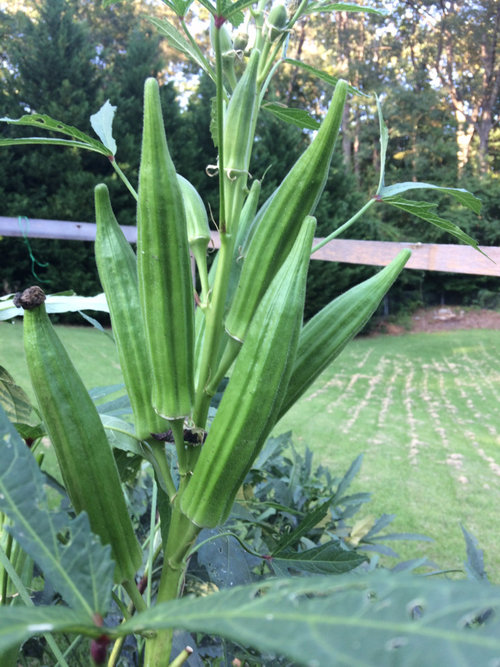
:max_bytes(150000):strip_icc()/growing-okra-in-the-backyard-vegetable-garden-1403473-04-e41a375384f742feb1a0fb1ca6cac55a.jpg)

The pollens are spherical and approximately 188 microns in diameter. The flowers are 4–8 centimetres ( 1 + 5⁄ 8– 3 + 1⁄ 8 in) in diameter, with five white to yellow petals, often with a red or purple spot at the base of each petal. The leaves are 10–20 centimetres (4–8 in) long and broad, palmately lobed with 5–7 lobes. As a member of the Malvaceae, it is related to such species as cotton, cocoa, and hibiscus. The species is a perennial, often cultivated as an annual in temperate climates, often growing to around 2 metres (6 ft 7 in) tall. From Arabia, the plant spread around the shores of the Mediterranean Sea and eastward. One of the earliest European accounts is by a Spanish Moor who visited Egypt in 1216 and described the plant under cultivation by the locals who ate the tender, young pods with meal. The plant may have entered southwest Asia across the Red Sea or the Bab-el-Mandeb strait to the Arabian Peninsula, rather than north across the Sahara, or from India. The Egyptians and Moors of the 12th and 13th centuries used the Arabic word for the plant, bamya, suggesting it had come into Egypt from Arabia, but earlier it was probably taken from Ethiopia to Arabia. The geographical origin of okra is disputed, with supporters of Southeast Asian, South Asian, Ethiopian and West African origins.

Truly wild (as opposed to naturalised) populations are not known with certainty, and the West African variety has been described as a cultigen.

However, proposed parents include Abelmoschus ficulneus, A. tuberculatus and a reported "diploid" form of okra. Okra is an allopolyploid of uncertain parentage. Despite the fact that in most of the United States the word gumbo often refers to the dish, gumbo, many places in the Deep South may have used it to refer to the pods and plant as well as many other variants of the word found across the African diaspora in the Americas. The word gumbo was first recorded to be used in American vernacular around 1805, deriving from Louisiana Creole, but originates from either the Umbundu word ochinggômbo or the Kimbundu word ki-ngombo. The first use of the word okra (alternatively okro or ochro) appeared in 1679 in the Colony of Virginia, deriving from the Igbo word ọ́kụ̀rụ̀. Each Okra garden ships with two okra plants and two herbs plants.Abelmoschus is New Latin from Arabic أَبُو المِسْك (ʾabū l-misk, “father of musk”), while esculentus is Latin for being fit for human consumption. If you are interested, email and we will match you to the right farm partner for your summer okra garden. Gardenuity is working with our farm partners and has limited okra collections available. It’s truly a delight to grow okra - it looks beautiful (like mini trees!) and tastes delicious.
#FULL GROWN OKRA PLANT PRO#
PRO TIP: Remove pods that are too big to eat regardless, because they’ll take up the plant’s energy stores and exhaust the plant.Īfter you harvest your Okra try these 2 okra recipes! It’s absolutely delicious! You may want to wear gloves - okra has stiff leaf hairs that can be uncomfortable to the touch!
#FULL GROWN OKRA PLANT HOW TO#
How to HarvestĬut the pods off with pruning shears, leaving a short stub of stem attached. When the pods are 2-4 inches long, harvest! They’ll get tough and stringy otherwise. They will grow very quickly and can appear and mature within 2 or 3 days. Once you see these pods, check your plants regularly. Usually, the pods appear about 50-60 days after planting. Eventually, they’ll start to produce yellow blossoms followed by tender pods. As they grow, your plants will gain height and the bigger leaves. The warmer the weather, the faster the growth. The early growth of okra is slow, but quickly picks up speed. If it gets chilly at night where you are, wheel your okra inside. Ideally, nights should be at least 60° F and the days should be 85° or warmer. Plant in a container garden and follow the sun! Even with temperatures edge near 100 degrees, your okra will continue to thrive. Okra thrives when temperatures get above 85 degrees and continue to flourish with temperatures 90 degrees or higher.
#FULL GROWN OKRA PLANT FULL#
Okra requires full sun, at least six to eight hours per day, and warm temperatures. So no matter what, plant well after the last frost when the ground and air have warmed up. Okra needs full sun and warm weather (it thrives in the Deep South for a reason). Soon, you’ll be frying it up (or charring it) regularly. Read on to discover everything you need to know to grow okra successfully. Typically grown in the Deep South, you can grow okra almost anywhere in the continental United States if the timing is right. Famously known for gumbo and being fried, okra is the mild and tender legume we cannot get enough of this year.


 0 kommentar(er)
0 kommentar(er)
